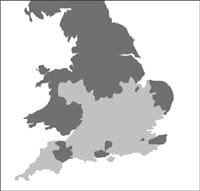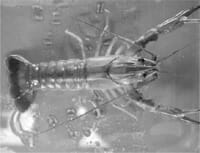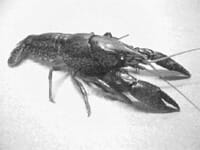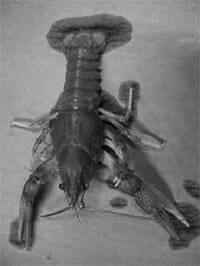Introduction
The thought at that time was that this species offered an ideal opportunity for diversification on agricultural holdings with natural or man made irrigation ponds. It was quickly realised that the production levels from such sites were lower than those advocated by the people promoting this business opportunity. This created problems in marketing, due to a short harvesting season and low, unreliable yield.
Invariably most signal crayfish farming initiatives collapsed, such that from a peak of 99 registered crayfish farms in 1992, there are now only 4 registered in England and Wales. A major problem with the introduction of signal crayfish into farm ponds was that, as populations grew, they naturally migrated through drainage systems or overland into natural watercourses where they quickly became established. Signal crayfish spread rapidly over much of the South of England, and as it spread, the true environmental impact of this species started to become apparent.
Other non-native crayfish species have also become established, but have more limited distributions in the U.K. These populations were largely a result of releases from the food trade but also, it is rumoured, via deliberate introductions by anglers into fisheries. Legislation was introduced in 1996 to prohibit the keeping of non-native crayfish, but while this has reduced the incidence of new species, it has largely failed to stop the spread of signal crayfish to new areas. There is still a very real threat that more non-native crayfish species could be introduced into Great Britain which if released into the wild could be just as, if not more, damaging than the signal crayfish.
Environmental Impact
The signal crayfish has had a significant impact on the ecosystems it has colonised in Great Britain. It is a fast growing, highly fecund, aggressive, veracious species, which has few natural predators once it reaches maturity. Being omnivorous they will eat most small aquatic fauna and flora. Signal crayfish burrow, causing extensive damage to riparian verges and subsequently to the whole ecosystem. They predate on and out-compete a number of native species, including several environmentally important fish such as bullheads and stone loach, amphibians, and invertebrate species. Of particular note is the white-clawed crayfish (Austropotamobius pallipes), the only native crayfish species in the U.K. The white-clawed crayfish has been in significant decline in parts of England for some time. This can be attributed to a number of factors, such as pollution and habitat degradation, but an increasingly significant factor has been directcompetition and predation by signal crayfish. To compound the situation further, North American crayfish species, including the signal crayfish, carry a fungal infection called the crayfish plague (Aphanomyces astaci), which is lethal to European crayfish (including our native white-clawed crayfish) and has resulted in their eradication from a number of waters in England. The presence of signal crayfish places a major restriction on national efforts to protect and rehabilitate our native crayfish species.
 |
 |
| Fig. 1. Controlled (no-go) areas (dark grey) where a licence is required to keep signal crayfish and uncontrolled (go) areas (light grey) where a licence is not required. | Fig 2. Red-claw crayfish (Cherax quadricarinatus) |
Legal Protection
The Wildlife and Countryside Act 1981
This Act introduced a range of protective measures for native fauna and flora, unfortunately somewhat late to prevent the escape of signal crayfish from farms to natural waters. This Act made it an offence to release, or allow the escape of any non-native species to the wild. Therefore, the introduction of nonnative crayfish into water bodies from which they can escape, such as rivers, ponds, lakes, fisheries and farm ponds constitutes an offence under the Act.
The provisions of the Act were extended in 1992, to ensure that those non-native crayfish which had established populations in Great Britain were still legally classed as non-natives and therefore remained subject to all of the Act. As a result, it remains illegal to introduce signal crayfish into waters other than those from which it would be impossible for them to escape. The Act amendments also improved protection for the native crayfish, by introducing offences of taking or selling this species without a licence.
The Prohibition of Keeping of Live fish (Crayfish) Order 1996
Made under the Import of Live Fish Act (1980), this Order (Crayfish Order) makes it an offence to keep any non-native species of crayfish in England and Wales without a licence (there is equivalent legislation in Scotland). An exception was made for signal crayfish in certain parts of England and Wales where extensive wild populations already existed before the order was introduced (see Fig 1), although introductions into these areas would still come under the Wildlife and Countryside Act.
A general licence was issued under this Order for the keeping of tropical species for ornamental purposes in heated indoor aquaria. At present the Australian red-claw (Cherax quadricarinatus) (Fig 2) is the only species recognised to be truly tropical. Another general licence was granted authorising the keeping of non-native crayfish in restaurants, markets and hotels for direct human consumption, although these animals still have to be held in secure conditions. Individual licences have been issued for the keeping of non-native crayfish for farming, scientific research or educational purposes, where the facilities are adequate to ensure that the animals cannot escape into natural waters and access to the animals is restricted. The Crayfish Order effectively makes it illegal to possess any nonnative crayfish species, other than the red-claw, unless those crayfish are going for human consumption.
Farming crayfish
Despite the original failures of signal crayfish farming anyone still wishing to attempt to start farming non-native crayfish could be licensed providing the animals are kept in secure, indoor facilities or, additionally for signal crayfish in the go-areas in escape-proofed, fully enclosed outdoor ponds. There is limited information available on high-density indoor culture of crayfish, and given the economic conditions it seems unlikely that any such venture would be viable. A detailed case would have to be submitted to the Fish Health Inspectorate (FHI), Cefas, and approved by the Environment Agency, Natural England (or CCW) and Defra before a licence would be granted. In addition any such farm would need to be registered with the FHI. While the Crayfish Order allows the keeping of the Australian red-claw crayfish for ornamental purposes, anyone wishing to start farming this species would also require licensing due to the additional risk that large number of these animals may pose if not held securely. Fig. 1. Controlled (no-go) areas (dark grey) where a licence is required to keep signal crayfish and uncontrolled (go) areas (light grey) where a licence is not required.
Other non-native crayfish
Despite measures taken to try and protect our native and prevent the introduction and spread of non-native crayfish, signal crayfish can now be found as far north as parts of Scotland. Most of these populations result from introductions by man, usually in ignorance of the legislative restrictions and typically using animals supplied from go-areas in the south of England.
Other non-native crayfish species have also become established in the U.K. The 4 species, other than the signal crayfish, now established in the U.K. are: red-swamp (Procambarus clarkii) and spiny checked crayfish (Orconectes limosis) from North America (crayfish plague carriers), as well as noble (Astacus astacus) and Turkish crayfish (Astacus leptodactylus) from mainland Europe (crayfish plague susceptible). Most of these populations resulted from release or escape of crayfish imported into the U.K. for human consumption or the aquarium trade. Although these species have yet to cause as much damage to the environment as signal crayfish, their presence in the country highlights routes of introduction that have lead to the establishment of wild populations.
Non-native crayfish are still entering the country and being kept illegally; a recent example of this is the discovery by the FHI of an increasing number of marbled crayfish being kept illegally and sold in pet shops. The marbled crayfish (Procambarus sp., Fig 3.) is the first recorded crayfish capable of asexual reproduction (parthenogenesis). An adult is capable of producing up to 270 eggs every 8–9 weeks with maturity being reached 25–35 weeks after hatching, under optimum conditions. This means that only one animal is required to establish a breeding population.
Thought to be possibly of North American origin (and therefore a plague carrier), marbled crayfish first appeared in the aquarium trade in Germany and Austria in the mid-1990s. The species has been released or has escaped into natural waters in Europe, though its impact in these areas has yet to be assessed.
To maintain their high breeding output, marbled crayfish use vast amounts of energy, so they are voracious feeders and will consume a broad range of aquatic plants and invertebrates, and scavenge on other food sources. This poses a risk that they may have a direct impact on native aquatic fauna and flora if released to natural waters.
Because the marbled crayfish can reproduce rapidly, hobbyists could pass excess stock onto other hobbyists or pet shops, or even release them into the wild. Marbled crayfish can survive in temperate water, so there is a concern that this alien species will become established in Great Britain if released.
The FHI is making efforts to track the source of these crayfish, and to educate the trade and hobby aquarists not to buy or keep these animals. Where necessary the FHI will take action against anyone considered to be deliberately committing offences under the Crayfish Order.

Marbled crayfish (Procambarus sp.).
Prevention is the best cure
The effectiveness of many pieces of legislation is determined not specifically by what they say, but by the policy adopted by the bodies responsible for implementing or enforcing the legislation. The current legislation is very hard to enforce, for example it is impossible to prove that the release of a non-native aquatic animal has taken place, unless the act of release is observed. It is also difficult to licence and advise anyone holding non-native crayfish unless they are known to be undertaking such activities by the FHI.
One of the main contributing factors to this problem is the lack of public awareness both of the impact that non-native crayfish have on the environment and of the legislation controlling their keeping and release. Several organisations have tried to combat this, such as the Brecks Countryside Project, with great success in their local area. The ornamental Aquatic Trade Association (OATA) has done much to publicise the legislation to its members, and many individual members of the aquarium trade have also been of great help in educating their customers about the restricted availability of crayfish as ornamental animals. One such company (Creature Comforts, Totton, Hampshire) was instrumental in bringing the occurrence of marbled crayfish in trade to the attention of the FHI. Nevertheless, public awareness of these problems needs to be raised to prevent further damage to our environment by non-native crayfish species. We hope that this article has helped raise awareness amongst the fish farming community and that the message will spread through your contacts with other components of the aquatic animal trade in Britain.
If you are aware of any activities involving the sale or keeping of non-native crayfish that could involve a breach of the legislation discussed above please contact the Fish Health Inspectorate on 01305 206673 or email fish. health.inspectorate@cefas.co.uk/. All information will be treated in the strictest of confidence and will be dealt with in a sensitive manner.
We would also like to receive information about mortality events in crayfish populations or sightings of unusual crayfish specimens in natural waters. The FHI are also happy to provide information on the importation, keeping and farming of crayfish.

Turkish crayfish (Astacus leptodactylus).
March 2008

